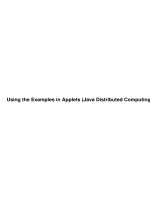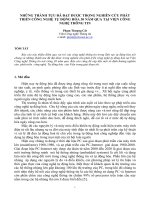Tài liệu Griffon in Action pptx
Bạn đang xem bản rút gọn của tài liệu. Xem và tải ngay bản đầy đủ của tài liệu tại đây (15.89 MB, 386 trang )
MANNING
Andres Almiray
Danno Ferrin
James Shingler
FOREWORD BY Dierk König
www.it-ebooks.info
Griffon in Action
www.it-ebooks.info
www.it-ebooks.info
Griffon in Action
ANDRES ALMIRAY
DANNO FERRIN
JAMES SHINGLER
MANNING
S
HELTER
I
SLAND
www.it-ebooks.info
For online information and ordering of this and other Manning books, please visit
www.manning.com. The publisher offers discounts on this book when ordered in quantity.
For more information, please contact
Special Sales Department
Manning Publications Co.
20 Baldwin Road
PO Box 261
Shelter Island, NY 11964
Email:
©2012 by Manning Publications Co. All rights reserved.
No part of this publication may be reproduced, stored in a retrieval system, or transmitted, in
any form or by means electronic, mechanical, photocopying, or otherwise, without prior written
permission of the publisher.
Many of the designations used by manufacturers and sellers to distinguish their products are
claimed as trademarks. Where those designations appear in the book, and Manning
Publications was aware of a trademark claim, the designations have been printed in initial caps
or all caps.
Recognizing the importance of preserving what has been written, it is Manning’s policy to have
the books we publish printed on acid-free paper, and we exert our best efforts to that end.
Recognizing also our responsibility to conserve the resources of our planet, Manning books
are printed on paper that is at least 15 percent recycled and processed without the use of
elemental chlorine.
Manning Publications Co. Development editor: Cynthia Kane
20 Baldwin Road Technical proofreader: Al Scherer
PO Box 261 Copyeditors: Tiffany Taylor, Andy Carroll
Shelter Island, NY 11964 Proofreader: Melody Dolab
Typesetter: Dennis Dalinnik
Cover designer: Marija Tudor
ISBN: 9781935182238
Printed in the United States of America
1 2 3 4 5 6 7 8 9 10 – MAL – 18 17 16 15 14 13 12
www.it-ebooks.info
v
brief contents
P
ART
1 G
ETTING
STARTED
1
1
■
Welcome to the Griffon revolution 3
2
■
A closer look at Griffon 36
P
ART
2 E
SSENTIAL
G
RIFFON
57
3
■
Models and binding 59
4
■
Creating a view 92
5
■
Understanding controllers and services 117
6
■
Understanding MVC groups 138
7
■
Multithreaded applications 160
8
■
Listening to notifications 191
9
■
Testing your application 211
10
■
Ship it! 242
11
■
Working with plugins 258
12
■
Enhanced looks 277
13
■
Griffon in front, Grails in the back 302
14
■
Productivity tools 322
www.it-ebooks.info
www.it-ebooks.info
vii
contents
foreword xv
preface xvii
acknowledgments xix
about this book xxii
about the cover illustration xxvi
P
ART
1 G
ETTING
STARTED
1
1
Welcome to the Griffon revolution 3
1.1 Introducing Griffon 4
Setting up your development environment 5
■
Your first
Griffon application 7
1.2 Building the GroovyEdit text editor in minutes 9
Giving GroovyEdit a view 9
■
Making the menu items behave:
the controller 14
■
How about a tab per file? 16
Making GroovyEdit functional: the FilePanel model 18
Configuring the FilePanel controller 19
1.3 Java desktop development: welcome to the jungle 22
Lots of boilerplate code (ceremony vs. essence) 23
■
UI definition
complexity 24
■
Lack of application life cycle management 26
No built-in build management 27
www.it-ebooks.info
CONTENTS
viii
1.4 The Griffon approach 27
At the core: the MVC pattern 28
■
The convention-over-
configuration paradigm 31
■
Groovy: a modern
JVM language 33
1.5 Summary 35
2
A closer look at Griffon 36
2.1 A tour of the common application structure 37
2.2 The ABCs of configuration 39
A is for Application 40
■
B is for Builder 41
C is for Config 43
2.3 Using Griffon’s command line 47
Build command targets 49
■
Run command targets 50
Miscellaneous command targets 50
2.4 Application life cycle overview 51
Initialize 52
■
Startup 53
■
Ready 53
Shutdown 54
■
Stop 55
2.5 Summary 56
P
ART
2 E
SSENTIAL
G
RIFFON
57
3
Models and binding 59
3.1 A quick look at models and bindings 60
Creating the project 60
■
Creating the model 61
Creating the view 62
■
Creating the controller 63
3.2 Models as communication hubs 64
MVC in the age of web frameworks 65
Rethinking the pattern 66
3.3 Observable beans 66
JavaBeans bound properties: the Java way 67
■
JavaBeans bound
properties: the Groovy way 69
■
Handy bound classes 72
3.4 Have your people call my people: binding 74
A basic binding call 75
■
The several flavors of binding 76
Finding the essence 77
■
Other binding options 80
3.5 The secret life of BindingUpdatable 83
Keeping track of bindings with the BindingUpdatable object 83
Managing the bindstorm: bind(), unbind(), and rebind() 84
www.it-ebooks.info
CONTENTS
ix
Manually triggering a binding: update() and reverseUpdate() 85
Grouping bindings together 85
3.6 Putting it all together 86
Setting up the model 87
■
Defining a view 87
Adding the missing validations to the model 89
3.7 Summary 91
4
Creating a view 92
4.1 Java Swing for the impatient 93
“Hello World” the Swing way 94
■
Extending “Hello World”:
“Hello Back” 95
■
Swing observations 96
4.2 Groovy SwingBuilder: streamlined Swing 97
“Hello World” the SwingBuilder way 98
“Hello Back” with SwingBuilder 99
4.3 Anatomy of a Griffon view 100
Builders are key to views 101
Nodes as building blocks 102
4.4 Using special nodes 104
Container 104
■
Widget 104
■
Bean 105
Noparent 105
■
Application 106
4.5 Managing large views 106
Rounding up reusable code 107
■
Breaking a large view
into scripts 107
■
Organize by script type 109
4.6 Using screen designers and visual editors 110
Integrating with the NetBeans GUI builder
(formerly Matisse) 110
■
Integrating with
Abeille Forms Designer 114
4.7 Summary 116
5
Understanding controllers and services 117
5.1 Dissecting a controller 118
Quick tour of injected properties and methods 118
Using the post-initialization hook 121
Understanding controller actions 122
5.2 The need for services 124
Creating a simple service 125
■
Creating a
Spring-based service 126
www.it-ebooks.info
CONTENTS
x
5.3 Artifact management 130
Inspecting artifacts 130
■
Metaprogramming on artifacts 133
Artifact API in action 133
5.4 Summary 137
6
Understanding MVC groups 138
6.1 Anatomy of an MVC group 139
A look at each member 139
■
Registering the MVC group 141
Startup groups 142
6.2 Instantiating MVC groups 143
Creation methods 143
■
Marshaling the MVC
type instances 144
■
Initializing group members 147
Advanced techniques 148
6.3 Using and managing MVC groups 151
Accessing multiple MVC groups 151
Destroying MVC groups 153
6.4 Creating custom artifact templates 155
Templates, templates, templates 156
■
It’s alive! 158
6.5 Summary 159
7
Multithreaded applications 160
7.1 The bane of Swing development 161
Java Swing without threading 161
■
Java Swing
with threading 163
7.2 SwingBuilder alternatives 166
Groovy Swing without threading 166
■
Groovy Swing
with threading 167
■
Synchronous calls with edt 170
Asynchronous calls with doLater 171
■
Outside calls
with doOutside 171
7.3 Multithreaded applications with Griffon 172
Threading and the application life cycle 172
Threading support the Griffon way 173
Controller actions and multithreading:
a quick guide 173
■
Fine-tuning threading
injection 175
■
What about binding? 176
7.4 SwingXBuilder and threading support 177
Installing SwingXBuilder 177
The withWorker() node 178
www.it-ebooks.info
CONTENTS
xi
7.5 Putting it all together 179
Defining the application’s outline 180
■
Setting up the
UI elements 181
■
Defining a tab per loading technique 182
Adding the loading techniques 184
■
FileViewer:
the aftermath 187
7.6 Additional threading options 188
Synchronous calls in the UI thread 188
■
Asynchronous calls in
the UI thread 189
■
Executing code outside of the UI thread 189
Is this the UI thread? 189
■
Executing code asynchronously 189
7.7 Summary 190
8
Listening to notifications 191
8.1 Working with build events 192
Creating a simple script 192
■
Handling an event with
the events script 193
■
Publishing build events 195
8.2 Working with application events 196
E is for events 196
■
Additional application event handlers 198
Firing application events 201
8.3 Your class as an event publisher 205
A basic Marco-Polo game 206
■
Running the application 209
8.4 Summary 210
9
Testing your application 211
9.1 Griffon testing basics 212
Creating tests 213
■
Running tests 214
Testing in action 217
9.2 Not for the faint of heart: UI testing 220
Setting up a UI component test 221
A hands-on FEST example 223
9.3 Testing with Spock and easyb 228
Spock reaches a new level 228
■
FEST-enabled
Spock specifications 232
■
easyb eases up BDD 233
9.4 Metrics and code inspection 236
Java-centric tools: JDepend and FindBugs 236
■
Reporting Groovy
code violations with CodeNarc 236
■
Measuring Groovy
code complexity with GMetrics 238
■
Code coverage
with Cobertura 239
9.5 Summary 240
www.it-ebooks.info
CONTENTS
xii
10
Ship it! 242
10.1 Understanding the common packaging options 243
10.2 Using Griffon’s standard packaging targets 244
The jar target 244
■
The zip target 246
■
The applet and
webstart targets 247
■
Customizing the manifest 247
Customizing the templates 248
10.3 Using the Installer plugin 250
Building a distribution 251
■
The izpack target 252
The rpm target 253
■
The deb target 254
The mac target 255
■
The jsmooth target 255
The windows target 255
■
Tweaking a distribution 255
10.4 Summary 257
11
Working with plugins 258
11.1 Working with plugins 259
Getting a list of available plugins 259
■
Getting plugin-specific
information 260
■
Installing a plugin 261
Uninstalling a plugin 262
11.2 Understanding plugin types 262
Build-time plugins 263
■
Runtime plugins 265
11.3 Creating the Tracer plugin and addon 267
Bootstrapping the plugin/addon 268
■
Intercepting property
updates 269
■
Using the plugin 270
■
Intercepting
action calls 272
■
Running the plugin again 273
11.4 Releasing the Tracer plugin 274
11.5 Summary 276
12
Enhanced looks 277
12.1 Adding new nodes 278
Registering node factories 278
■
Using an implicit addon 282
Creating a builder 283
12.2 Builder delegates under the hood 285
Acting before the node is created 286
■
Tweaking the
node before properties are set 286
■
Handling node properties
your way 287
■
Cleaning up after the node is built 287
www.it-ebooks.info
CONTENTS
xiii
12.3 Quick tour of builder extensions in Griffon 288
SwingXBuilder 288
■
JideBuilder 291
■
CSSBuilder 293
GfxBuilder 296
■
Additional builders 300
12.4 Summary 301
13
Griffon in front, Grails in the back 302
13.1 Getting started with Grails 303
13.2 Building the Grails server application 304
Creating domain classes 304
■
Creating the controllers 305
Running the Bookstore application 306
13.3 To REST or not 307
Adding controller operations 307
■
Pointing to resources
via URL 309
13.4 Building the Griffon frontend 311
Setting up the view 312
■
Updating the model 314
13.5 Querying the Grails backend 315
Creating a service 315
■
Injecting an instance of the service 317
Configuring the Bookstore application 318
13.6 Alternative networking options 320
13.7 Summary 321
14
Productivity tools 322
14.1 Getting set up in popular IDEs 323
Griffon and Eclipse 323
■
Griffon and NetBeans IDE 327
Griffon and IDEA 331
■
Griffon and TextMate 334
14.2 Command-line tools 336
Griffon and Ant 336
■
Griffon and Gradle 338
Griffon and Maven 340
14.3 The Griffon wrapper 340
14.4 Summary 341
appendix Porting a legacy application 342
index 350
www.it-ebooks.info
www.it-ebooks.info
xv
foreword
As soon as I heard about Griffon in Action, I was eager to get it into my hands. What I
expected was a typical Manning In Action book: providing an easy jump start, working
from actionable examples, and providing lots of insight about the technology at hand.
It turned out that this book not only lived up to my expectations, it exceeded them in
many ways.
First, the authors’ knowledge is indisputable. This is obvious for the technology,
because we’re talking about main Griffon contributors. But beyond that comes experi-
ence about all aspects of developing desktop applications based on Swing, ranging
from how to set up your project, through proper separation of concerns, threading,
building, testing, visual composition, and code metrics, down to how to deliver the
final application to the customer.
Second, the book goes beyond giving simple recipes. It explains the underlying
constraints and considerations that enable readers to make informed decisions about
their projects.
Third, Griffon in Action is a great reference. I have it open whenever I write Griffon
applications so I can quickly look up an example or a list of available goodies. It is
such a thorough source of information that I consider it the definitive guide.
Writing such a book is a huge effort—especially when aiming for approachability
and completeness at the same time. Additionally, the authors pushed the Griffon proj-
ect forward while writing this book, and one or the other may even have an additional
day job.
www.it-ebooks.info
FOREWORD
xvi
A big “thank you” to the authors of this book; and to you, readers, a warm-hearted
“Keep groovin’.”
DIERK KÖNIG
Author of Groovy in Action
First and Second Editions
www.it-ebooks.info
xvii
preface
The book you’re holding in your hands went through a lot of iterations before it
reached its final form. We’re not referring to the editorial process, but rather to the
deep relationship it has with the topic it discusses: the Griffon framework. Both
evolved at the same time almost from the beginning.
On a peaceful October afternoon back in 2007, Danno Ferrin, James Williams, and
I (all members of the Groovy development team) had a very productive chat over
Skype about the future of Groovy’s SwingBuilder—an enabler for writing desktop
GUI
s using Swing as a
DSL
. We recognized the potential of mixing and matching dif-
ferent builders to write richer
UI
s, but the current syntax wasn’t pleasant to use. We
drafted a plan and got to work on our respective areas.
Fast-forward to JavaOne 2008, where the three of us got to meet face to face for the
first time. Joined by Guillaume Laforge, we hatched the idea of what was to become
the Griffon framework. We knew that Grails was making waves in the web space, and
we felt the need for a similar outcome in the desktop space. Cue the light-bulb
moment: we agreed that creating a desktop framework that stuck as closely as possible
to Grails would be the way to go—although we didn’t have a name for it yet.
Danno went back to his batcave after the conference and in a matter of weeks
bootstrapped the framework by forking Grails and removing all the webby stuff that
was not needed. Then he grafted in the most important pieces of Griffon’s architec-
ture: the UberBuilder, the
MVC
group conventions, and the application life cycle.
We finally had something tangible. James picked the name and we went public
with the project on September 2008. The initial reaction from the community was so
www.it-ebooks.info
PREFACE
xviii
positive than in a matter of months work on the book began. And this is where both
projects got intertwined.
Together with Danno and Geertjan Wielenga, we wrote the first part of the book.
We went to work on the framework, and then we came back to the book when we
stopped to rethink where we were going with the framework. This kept going for
months: hacking some code, writing a few pages. In the meantime, we received plenty
of feedback about both projects. A particular advantage of this setup was that we were
able to address the needs of users and readers and thus save time, the most precious
resource for an open source effort.
Eventually Geertjan and Danno reduced their contributions, and my coauthor and
good friend Jim Shingler joined the project. Being an early adopter of the technology
plus a seasoned Swing developer meant he was the right person for the job. And he
didn’t disappoint. Thank you, Jim!
All this leads to where we are now, with you reading these pages. During the time
it took to get the book into your hands, we painstakingly revised its goals and the
framework, making sure both were kept as accurate and fresh as possible. Despite
what the naysayers have said for years—that Java on the desktop is no longer rele-
vant—the current situation couldn’t be further from the truth. Griffon has been used
to write applications that manage patient data, process the data required to manage
the railroad schedule of an entire country, and even talk to a satellite in space!
It’s our hope that you’ll find the book to be the best resource for starting to work
with this technology. Keep it close as a reference when you’re in doubt about how to
use a particular feature.
Enjoy!
ANDRES ALMIRAY
www.it-ebooks.info
xix
acknowledgments
Griffon in Action is the culmination of the efforts of a lot of people, without whom we
would not have been able to accomplish its publication. We would like to begin by
thanking Josh A. Reed for pitching the book during an autumn conversation as well as
Christina Rudloff at Manning for getting the ball rolling. We need to express our appre-
ciation to our development editors, Tara McGoldrick Walsh, Lianna Wlasiuk, and
Cynthia Kane. Associate publisher Michael Stephens organized the project and got us on
track to get the book finished in a timely and organized manner. Thanks to our editorial
director Maureen Spencer, and to our copy editors, Tiffany Taylor and Andy Carroll, for
making our writing readable. And thanks to the rest of the Manning staff, including
Melody Dolab, Karen Tegtmeyer, Steven Hong, and Candace Gillhoolley.
It’s important that a technical book be accurate, so we would like to thank our for-
mal technical reviewers, Dean Iverson, Dierk König, and Al Scherer. We also thank
those who read the book and provided feedback during various stages of the book’s
development: Geertjan Wielenga, Venkat Subramanian, Ken Kousen, Scott Davis,
Michael Kimsal, Peter Niederwiser, Alex Ruiz, Guillaume Laforge, Dierk König,
Hamlet D’Arcy, Gerrit Grünwald, Carl Dea, Dave Klein, Santosh D. Shanbhag, Edward
Gibbs, Bob Brown, Doug Warren, Shawn Hartsock, Jean-Francois Poilpret, Amos
Bannister, Gordon Dickens, Glen Smith, Jonas Bandi, Mykel Alvis, Eitan Suez, Sven
Haiges, Jonathan Giles, Robby O'Connor, Josh Reed, and James Williams. We also
thank Dierk for contributing the foreword to our book.
Thanks to all those who have contributed to the Groovy, Griffon, and Grails projects,
especially Guillaume Laforge, Graeme Rocher, Jochen Theodoru, Alex Tkachman, Paul
www.it-ebooks.info
ACKNOWLEDGMENTS
xx
King, Hans Dockter, Peter Niederwiser, Luke Daley, Spring Source, and VMWare. We
would also like to thank other Groovy, Griffon, and Grails community contributors,
including James Williams for SwingXBuilder, Alexander Klein for bringing new ideas
to the framework, and René Gröschke and his build-bending Gradle powers. They
have created some great stuff and should be proud of themselves. Thanks to Sven
Haiges, Glen Smith, and Peter Ledbrook for their informative Grails podcast, where
Griffon was present on several occasions. Other special mentions go to Peter for the
countless exchanges we had regarding Grails and Griffon; Dick “I loooove the Groovy”
Wall, Tor Norbye, Carl Quinn, and Joe Nuxoll for the Java Posse podcast; and Michael
Kimsal for Groovy Mag.
ANDRES ALMIRAY
First and foremost, I would like to thank my wife, Ix-chel, for being my rock, anchor,
companion, and soul mate. You wouldn’t be holding this book in your hands without
her patience, understanding, and driving force. I’d like to thank my parents for bringing
me into this world and for all their love through the years. Patricia and Astrud: where
would I be without all your help? A very special and warm thank you to Christianne,
Joseph, and Didier Muelemans, dear mentors and beacons of hope. We had a group
of professors back in college who shaped our professional lives and led us to where we
are. Bruno Guardia, Enrique Espinoza, Carlos Guerra, Angel Kuri, and Barbaro Ferro,
I’m grateful for all your lessons and your words of encouragement.
Danno Ferrin is the man with the plan. He wrote the initial pieces that eventually
led us to bring forth the Griffon framework. You rock!
Geertjan Wielenga started the book with us; sadly, he had to let it go after a while.
Still, his contributions in the early stages are deeply engrained in the book. Thank
you for keeping the light of desktop Java shining bright (and the NetBeans Griffon
plugin too!).
Thank you to the members of the Groovy community at large: Guillaume Laforge,
Graeme Rocher, Jochen Theodoru, Alex Tkachman, Paul King, Hans Dockter, Peter
Niederwiser, Luke Daley, Adam Murdoch, Dierk König, Hamlet D’Arcy, Roshan
Dawrani, Cédric Champeau, Stéphane Maldini, Dave Klein, Zachary Klein, Ben Klein,
Michael Kimsal, Jim Shingler, Chris Judd, Joseph Nusairat, Ken Kousen, Ken Sipe,
Andrew Glover, Venkat Subramanian, Scott Davis, Tim Berglund, Matthew
McCullough, Erik Wendelin, Burth Beckwith, Jeff Brown, Peter Ledbrook, Glen
Smith, Sven Haiges, Tim Yates, Marc Palmer, Robert Fletcher, Tomas Lin, Andre
Steingress, Andrew Eisenberg, Andy Clement, Peter Gromov, Colin Harrington,
Shawn Hartsock, Søren Berg Glasius, Hubbert Klein Ikkink, Sébastien Blanc, Vaclav
Pech, Russel Winder, Bernardo Gomez Palacios, Domingo Suarez, Jose Juan Reyes,
and Alberto Vilches.
Java on the desktop has evolved a lot since the platform’s inception back in 1995.
The following people have carried it on their shoulders and sent it forward: Amy
Fowler, Richard Bair, Jasper Potts, Joshua Marinacci, Hans Muller, Chet Haase, Scott
Violet, Chris Campbell, Shannon Hickey, Romain Guy, Kirill Grouchnikov, Mikael
www.it-ebooks.info
ACKNOWLEDGMENTS
xxi
Grev, Jean-Francois Poilpret, Karsten Lentzsch, Gerrit Grünwald, Jim Weaver, Stephen
Chin, Dean Iverson, Jim Clarke, Jonathan Giles, Carl Dea, Jeanette Winzenburg, and
Rémy Rakic.
Thanks to the friends and colleagues I’ve met across the years: el equipazo! (Artemio
Urbina, Jose Luis Balderas, Pedro Iniestra, and Francisco Macias), Ignacio Molina,
Agustin Ramos, Kevin Nilson, Mike van Riper, Alex Ruiz, Yvonne Price, Stoyan Vassilev,
Jay Zimmerman, Ben Ellison, Deepak Alur, Etienne Studder, Johannes Bühler, Sven
Herke, Alberto Mijares, Detlef Brendle, Sibylle Peter, Dieter Holz, and Hans-Dirk Walter.
Last but not least, thanks to Mac Liaw, the evil genius behind it all.
JIM SHINGLER
I would like to thank my wife, Wendy, and son, Tyler, for their support and patience
during the writing of the book and in our journey together through life. I would like
to thank all those who have contributed to my personal and professional growth over
the years: Wendy Shingler, Tyler Shingler, James L. Shingler Sr., Linda Shingler,
George Ramsayer, Chris Judd, Andres Almiray, Danno Ferrin, Tom Posival, Ken
Heintz, Bryce Kerlin, Rick Burchfield, David Lucas, Chris Nicholas, Tim Resch,
BJ
Allmon, Kevin Smith, Jeff Brown, Dave Klein, Paul King, Soren Berg Glasius, Michael
Kimsal, Joseph Nusairat, Brian Sam-Bodden. Steve Swing, Brian Campbell, Greg
Wilmer, Rick Fannin, Kunal Bajaj, Mukund Chandrasekar, Seth Flory, Frank
Neugebauer, David Duhl, Jason Gilmore, Teresa Whitt, Jay Johnson, Gerry Wright, and
the many other people who have touched my life. I’d also like to thank Jay Zimmerman,
Andrew Glover, Dave Thomas, Venkat Subramaniam, Scott Davis, Neal Ford, Ted
Neward, and the other great speakers and influencers on the “No Fluff Just Stuff” tour.
DANNO FERRIN
I would like to thank K.D., S.R., C.B, J.C., H.G., and H.F. for their support and patience.
www.it-ebooks.info
xxii
about this book
Griffon in Action is a comprehensive introduction to the Griffon framework that covers
the basic building blocks such as
MVC
groups, binding, threading, services, plugins,
and addons. But don’t let this quick summary fool you into thinking the topics are
covered lightly. The book provides deep dives into the topics at hand, following a
practical approach to get you started as quickly as possible.
Who should read this book
This book is for anyone interested in writing desktop applications for the Java virtual
machine (
JVM
). Whether you’re a seasoned Java developer or just starting on your
way, Griffon in Action will give you the knowledge to get started writing desktop applica-
tions in a productive manner and—why not?—have some fun while you’re at it.
Some experience with Java Swing is assumed. Previous experience with Grails is an
advantage, but we take the time to explain the crucial concepts where we think a com-
mon base should be explicitly stated. If you’re coming from another language back-
ground (such as Ruby or Python), you should find that using the Groovy language
comes naturally.
Roadmap
Griffon in Action gives a quick, accessible, no-fluff introduction to writing desktop appli-
cations in the Java universe.
The book is divided into four parts:
■
Part 1 Getting started
■
Part 2 Essential Griffon
www.it-ebooks.info
ABOUT THIS BOOK
xxiii
■
Part 3 Advanced Griffon
■
Part 4 Extending Griffon’s reach
We cover what Griffon is in chapter 1: where did it come from, and why was such a
development platform needed in the first place? This chapter presents theory along
with a good deal of practical advice and code—we want you to get a quick start right
off the bat.
In chapter 2, we explain the configuration options for an application both at com-
pile time and runtime. The command-line tools are discussed extensively.
In part 2 of the book, we go deep into the Griffon’s lair and explore the
MVC
com-
ponents found in every Griffon application. Our first stop is modeling data and estab-
lishing automatic updates via binding. We hope that by the end of chapter 3, you’ll
agree that binding makes life much easier that manually wiring up triggers; and event
listeners will be a task you cross off your list permanently.
Walking further into the den of the beast in chapter 4, we’ll discuss several tech-
niques for building a
UI
. Declarative programming is certainly within your reach, and
the fact that Griffon uses Groovy—a real programming language—makes things
much sweeter. You’ll find that the relationships between the different components
emerge naturally as you progress.
Closer to the nest, in chapter 5, are the components that form the logic of an
application: controllers and services. They’re responsible for routing events and data,
as well as responding to user events.
All the pieces will have fallen into place at this point, but you may have some unan-
swered questions regarding the relationships between components. Chapter 6 covers
in great detail how the platform manages its components and the facilities it puts at
your disposal to make the most out of them.
In part 3, we progress to more advanced topics. Building a responsive application
can be a daunting task, but in chapter 7 we’ll show you a few options that will help you
sort out multithreading obstacles with ease. Dealing with highly coupled components
is equally intimidating; but, fortunately, Griffon lets you react to well-timed events
depending on the application’s life cycle. You can even trigger your own events. And
did we mention that the event system is also useful for the command line? Events are
essential to building an application, and we’ll show you how to use them.
Chapter 8 offers complete coverage of notifications. Then, we’ll move to an often-
neglected aspect of desktop applications: proper testing, involving the
UI
. Griffon sim-
plifies that task as well, as we’ll explain in chapter 9.
Finally, we get into the subject of deployment in chapter 10. We cannot stress
enough how important it is to package the application in a way that customers can start
using it immediately. Griffon provides highly configurable options to gift-wrap that
application, and you need only concern yourself with how you’ll ship it to your custom-
ers. The beast should be tamed by now and comfortably accepting your commands.
We’ll begin part 4 by flying the friendly skies of plugins and extensions. We’ll bank
left to chart our way through chapter 11. Plugins, a key Griffon feature, let you as a
www.it-ebooks.info
ABOUT THIS BOOK
xxiv
developer customize further how applications are built and packaged, for example. In
chapter 12, we’ll climb up to the highest clouds, close to the stars, where the imagina-
tion roams freely through the vast expanse of customized views.
Before we complete our journey and shoot for the stars, you’ll put all your new-
found knowledge and training to the test in chapter 13. We’ll show you how to build a
prototype application that spans both desktop and web spaces, thanks to friendly
cooperation between Griffon and Grails.
You’ll want to keep your flying steed well nourished and in excellent condition. In
chapter 14, we’ll look at the most common tools, such as editors and build tools, that
you can use to maximize Griffon’s performance.
Code conventions
This book provides examples that demonstrate in a hands-on fashion how to use Grif-
fon features. Source code in listings or in text appears in a
fixed-width
font
like
this
to separate it from the ordinary text. In addition, class and method names,
object properties, and other code-related terms and content in text are presented
using the same
fixed-width
font
.
Code and command-line input/output can be verbose. In some cases, the original
source code (available online) has been reformatted; we’ve added line breaks and
reworked indentation to accommodate the page space available in the book. In rare
cases, when even this was not enough, line-continuation markers were added to show
where longer lines had to be broken.
Code annotations accompany many of the listings, highlighting important con-
cepts. In some cases, numbered cueballs link to additional explanations that follow
the listing.
Source code downloads
You can access the source code for all examples in the book from the publisher’s website:
www.manning.com/GriffoninAction. All source code for the book is hosted at GitHub
(github.com), a commercial Git hosting firm. We’ll maintain the current
URL
via the
publisher’s website, also mirrored at To
simplify finding your way, the source code is maintained by chapter.
Software requirements
All you need to get started is a working version of Oracle’s
JDK6
(available from http://
java.oracle.com) that matches your platform and operating system plus the latest sta-
ble Griffon release (from Additional soft-
ware may be required, such as plugins or tools; we’ll provide download instructions
when applicable.
www.it-ebooks.info









